一步步動手實現高併發的Reactor模型 —— Kafka底層如何充分利用多執行緒優勢去處理網路I/O與業務分發
一、從《Apeche Kafka原始碼剖析》上搬來的概念和圖
Kafka網路採用的是Reactor模式,是一種基於事件驅動的模式。熟悉Java程式設計的讀者應該瞭解Java NIO提供了Reactor模式的API。常見的單執行緒Java NIO程式設計模式如圖所示。
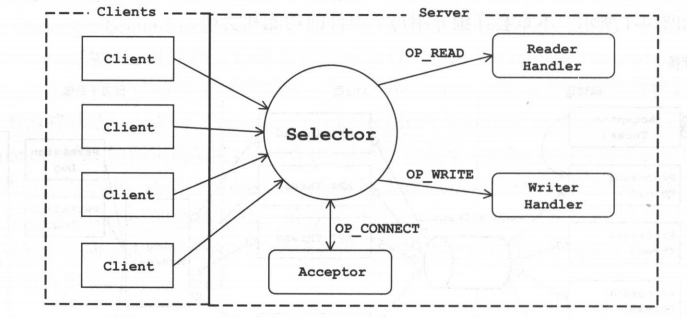
熟悉NIO程式設計都應該知道這個Selector,我們可以通過輪詢它來獲取監聽事件,然後通過事件來進行不同的處理,比如OP_ACCEPT連線,OP_READ讀取資料等等。
這樣簡單的處理對於客戶端是沒什麼問題,但對於服務端來說就有些缺點了。在服務端,我們要求讀取請求、處理請求以及傳送響應各個環節必須能迅速完成,並且要儘可能做到互不影響。所以我們就需要對上述簡單的模型進行修改。
為了滿足高併發的需求,也為了充分利用伺服器的資源,我們對上述的架構稍作調整,將網路讀寫的邏輯與業務處理的邏輯進行拆分,讓其由不同的執行緒池來處理,如圖所示。

二、套餐一:直接擼Kafka原始碼
如果不想看本文下面這個很挫的Reactor模型,可以直接看Kafka的原始碼 ~ 如果需要稍微藉助一點中文註釋,我已經標註了十分多的註釋~ 可以直接看這個版本,基於Kafka0.10.0.1的原始碼解讀 ,當然也可以直接去看官方版本。
SocketServer就是它的入口。
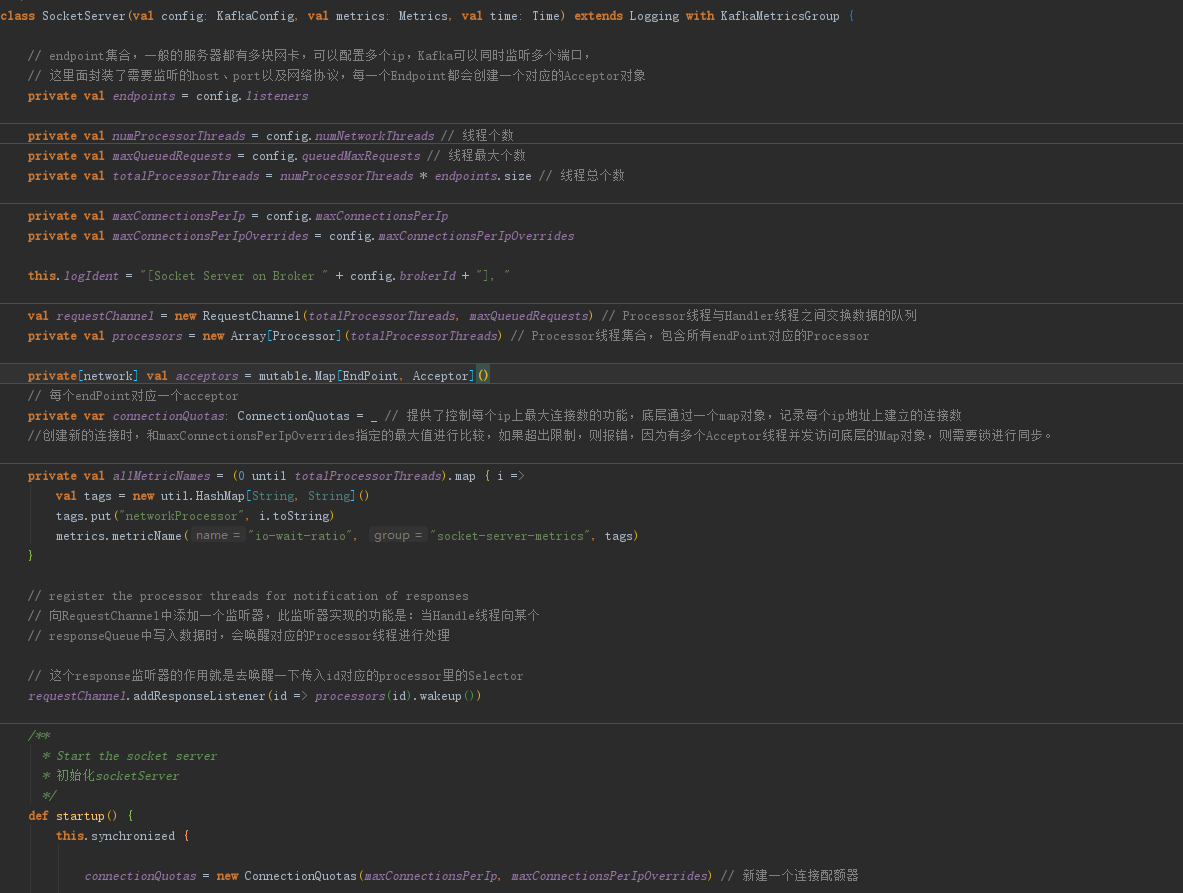
其中,內部類 Acceptor 負責建立並配置新連線
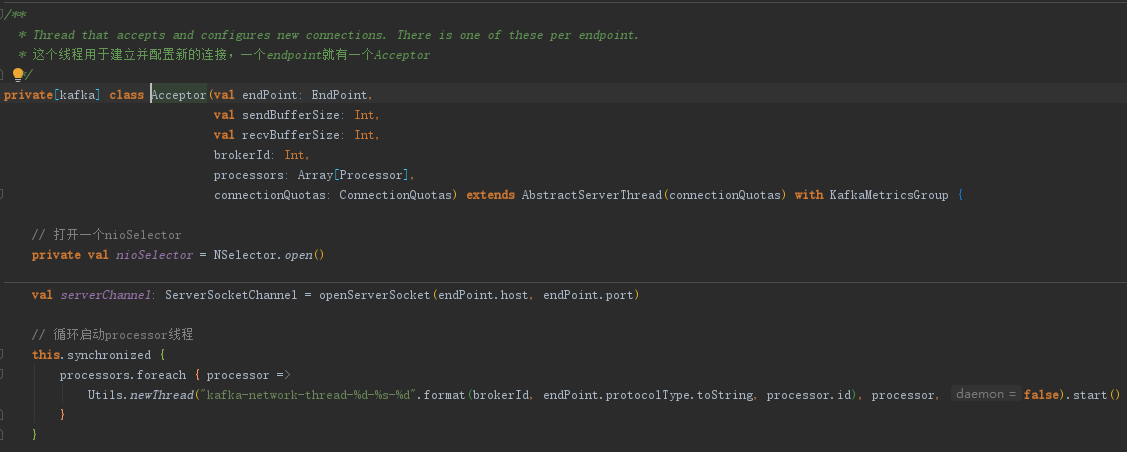
內部類 Processor 負責處理IO事件。

KafkaRequestHandler 這個類負責業務的處理。

而業務處理和IO之間的橋則是 RequestChannel。

三、套餐二:動手一步步實現Reactor模型
事先宣告,以下這個很挫(但也簡單)的Reactor模型只是保證它能用,而且思路和Kafka大致一致,並沒有去做很多的異常處理!!很多細節地方也做得不是很到位。
3.1 回憶一下selector是怎麼用的
//1. 獲取服務端通道 ServerSocketChannel ssChannel = ServerSocketChannel.open(); ssChannel.bind(new InetSocketAddress(9898)); //2. 設定為非阻塞模式 ssChannel.configureBlocking(false); //3. 開啟一個監聽器 Selector selector = Selector.open(); //4. 向監聽器註冊接收事件 ssChannel.register(selector, SelectionKey.OP_ACCEPT); while (selector.select() > 0) { //5. 獲取監聽器上所有的監聽事件值 Iterator<SelectionKey> it = selector.selectedKeys().iterator(); //6. 如果有值 while (it.hasNext()) { //7. 取到SelectionKey SelectionKey key = it.next(); //8. 根據key值判斷對應的事件 if (key.isAcceptable()) { //9. 接入處理 SocketChannel socketChannel = ssChannel.accept(); socketChannel.configureBlocking(false); socketChannel.register(selector, SelectionKey.OP_READ); } else if (key.isReadable()) { //10. 可讀事件處理 SocketChannel channel = (SocketChannel) key.channel(); readMsg(channel); } //11. 移除當前key it.remove(); } }
這就是我們上面提到的第一張圖的模型,我們發現它的IO操作和業務處理是雜糅在一起的。當然我們簡單的做可以使用一個業務處理的執行緒池負責處理業務。
但是我們這裡是要去實現第二個圖的模型~
3.2 實現負責建立連線的Acceptor
- 在 Acceptor 中監聽埠
public Acceptor(InetSocketAddress inetSocketAddress, Processor[] processors) throws IOException {
ServerSocketChannel serverSocketChannel = ServerSocketChannel.open();
serverSocketChannel.configureBlocking(false);
serverSocketChannel.socket()
.bind(inetSocketAddress);
this.serverSocketChannel = serverSocketChannel;
this.selector = Selector.open();
this.processors = processors;// 先忽略這個東西 = =
}
- 註冊 OP_ACCEPT 事件,並且不斷輪詢進行連線的建立,kafka在初始化中大量使用了CountdownLaunch來確保初始化的成功,這裡偷懶省去這一步驟。
@Override
public void run() {
if (init) {
System.out.println("已可以開始建立連線");
init = false;
}
try {
serverSocketChannel.register(selector, SelectionKey.OP_ACCEPT);
} catch (ClosedChannelException e) {
e.printStackTrace();
}
int currentProcessors = 0;
while (true) {
try {
int ready = selector.select(500); // 半秒輪詢一次
if (ready > 0) {
Set<SelectionKey> selectionKeys = selector.selectedKeys();
for (SelectionKey selectionKey : selectionKeys) {
if (selectionKey.isAcceptable()) {
this.accept(selectionKey, processors[currentProcessors]);
currentProcessors = (currentProcessors + 1) % processors.length;
} else {
throw new RuntimeException("不應該出現的情況,因為只訂閱了OP_ACCEPT");
}
}
}
} catch (IOException e) {
e.printStackTrace();
}
}
}
// 建立連線,並且使用RoundRobin分配給一個Processor,也就是負責IO的角色
public void accept(SelectionKey selectionKey, Processor processor) throws IOException {
SelectableChannel channel = selectionKey.channel();
SocketChannel socketChannel = ((ServerSocketChannel) channel).accept();
socketChannel.configureBlocking(false);
socketChannel.socket()
.setTcpNoDelay(true);
socketChannel.socket()
.setKeepAlive(true);
// 將需要連線的socketChannel轉交給processor去處理
processor.accept(socketChannel);
}
3.3 實現負責處理IO的Processor
- 新連線進來後的處理:這裡只是簡單將新建立的連線放在了newConnection中。
public Processor(String name, RequestChannel requestChannel, ConcurrentHashMap<SelectionKey, ArrayBlockingQueue<ByteBuffer>> inFlightResponse) throws IOException {
this.name = name;
this.newConnection = new ConcurrentLinkedQueue<>();
this.selector = Selector.open();
this.inFlightResponse = inFlightResponse;
this.requestChannel = requestChannel;
}
protected void accept(SocketChannel socketChannel) {
try {
System.out.println(name + "正在與" + socketChannel.getLocalAddress() + "建立連線");
} catch (IOException e) {
e.printStackTrace();
}
newConnection.add(socketChannel);
// 還需要wakeUp,如果輪詢阻塞了,告訴它可以不阻塞了
selector.wakeup();
}
- 處理newConnection,並註冊OP_READ,等待客戶端傳輸資料
@Override
public void run() {
while (true) {
/*
* 處理新連結
*/
while (!newConnection.isEmpty()) {
SocketChannel socketChannel = newConnection.poll();
try {
socketChannel.register(selector, SelectionKey.OP_READ);
} catch (ClosedChannelException e) {
e.printStackTrace();
}
}
新接收到的資料,我們會將其丟進 RequestChannel,並取消關注OP_READ,保證不會讓多個請求同時進來。
requestChannel.sendRequest(new Request(selectionKey, byteBuffer));// 接受完資料後,把資料丟進佇列
而最新處理完的資料,我們則會將其快取在 inFlightRequest ,並關注OP_WIRTE。這是仿照 Kafka 的 inFlightRequest 做的,當然做得很粗糙。
Kafka 的 inFlightRequest 是將對應每個節點請求/應答的請求和響應放在了佇列中,確保在同一時間段內,一個節點只會有一個請求和應答。這也巧妙的避開了拆包粘包問題,首先 Kafka 保證了不會同時對一個節點發送請求,其次,Kafka 使用了自定的協議(其實就是包頭上標明瞭整個包的長度再加上CRC校驗)來保證一次請求的完整性。
我們的Selector輪詢中,會將剛才在上一步中關注了OP_WRITE的SelectionKey連同要返回的資料一同拿出,並進行處理,處理完成後,取消關注OP_WRITE,並重新關注OP_READ。
- 處理新請求與新應答,我們將READ事件和WRITE事件放在了Processor來進行。
/*
* 將新應答放入緩衝佇列
*/
Response response = requestChannel.receiveResponse();
while (response != null) {
SelectionKey key = response.getSelectionKey();
key.interestOps(key.interestOps() | SelectionKey.OP_WRITE);
ArrayBlockingQueue<ByteBuffer> inFlight = inFlightResponse.getOrDefault(response.getSelectionKey(), new ArrayBlockingQueue<>(100));
inFlightResponse.put(response.getSelectionKey(), inFlight);
try {
inFlight.put(response.getByteBuffer());
} catch (InterruptedException e) {
e.printStackTrace();
}
response = requestChannel.receiveResponse();
}
int ready = selector.select(500);// 半秒輪詢一次
if (ready > 0) {
Set<SelectionKey> selectionKeys = selector.selectedKeys();
for (SelectionKey selectionKey : selectionKeys) {
/*
* 處理新請求
*/
if (selectionKey.isReadable()) {
System.out.println(name + "正在處理新請求");
SocketChannel socketChannel = (SocketChannel) selectionKey.channel();
ByteBuffer byteBuffer = ByteBuffer.allocate(1024);// 懶得定協議,就預設取這麼多吧 = =
socketChannel.read(byteBuffer);// TODO 劃重點
byteBuffer.flip();
requestChannel.sendRequest(new Request(selectionKey, byteBuffer));// 接受完資料後,把資料丟進佇列
selectionKey.interestOps(selectionKey.interestOps() & ~SelectionKey.OP_READ);// 不再關注read
}
/*
* 處理新應答
*/
if (selectionKey.isWritable()) {
System.out.println(name + "正在處理新應答");
ByteBuffer send = inFlightResponse.get(selectionKey)// // TODO 劃重點
.poll();
SocketChannel socketChannel = (SocketChannel) selectionKey.channel();
socketChannel.write(send);
selectionKey.interestOps(selectionKey.interestOps() & ~SelectionKey.OP_WRITE);
selectionKey.interestOps(selectionKey.interestOps() | SelectionKey.OP_READ);
}
}
}
- RequestChannel的實現實際上十分簡單..就是兩個佇列
/**
* Created by Anur IjuoKaruKas on 2018/12/13
*/
public class RequestChannel {
private ArrayBlockingQueue<Request> requestQueue;
private ArrayBlockingQueue<Response> responseQueue;
public RequestChannel() {
requestQueue = new ArrayBlockingQueue<>(100);
responseQueue = new ArrayBlockingQueue<>(100);
}
..........
}
3.4 實現負責處理業務的Handler
很容易想到,Handler 實際上就是負責從 RequestChannel 的 requestQueue 中拉取需要處理的資料,並塞回 RequestChannel 的 responseQueue 中。
我們可以根據接收資料的不同,來進行不同的業務處理。甚至如果需要拓展,這裡可以像 netty 一樣,僅僅把 Handler 當成Boss,具體業務的執行可以建立相應的執行緒池去進行處理,比如說 Fetch 業務比較耗時,我可以建立一個較大的執行緒池,去執行Fetch業務,而 Hello 業務,我們只需要 Executors.newSingleThreadExecutor() 即可。
@Override
public void run() {
while (true) {
Request request = requestChannel.receiveRequest();
if (request != null) {
System.out.println("接收的請求將由" + name + "進行處理");
handler(request.getSelectionKey(), request.getByteBuffer());
}
}
}
public void handler(SelectionKey selectionKey, ByteBuffer byteBuffer) {
byte[] bytes = byteBuffer.array();
String msg = new String(bytes);
try {
Thread.sleep(500); // 模擬業務處理
} catch (InterruptedException e) {
e.printStackTrace();
}
ByteBuffer response;
if (msg.startsWith("Fetch")) {
response = ByteBuffer.allocate(2048);
response.put("Fetch ~~~~~~~~~~".getBytes());
response.put(bytes);
response.flip();
} else if (msg.startsWith("Hello")) {
response = ByteBuffer.allocate(2048);
response.put("Hi ~~~~~~~~~~".getBytes());
response.put(bytes);
response.flip();
} else {
response = ByteBuffer.allocate(2048);
response.put("Woww ~~~~~~~~~~".getBytes());
response.put(bytes);
response.flip();
}
System.out.println(name + "處理完畢,正將處理結果返回給Processor");
requestChannel.sendResponse(new Response(selectionKey, response));
}
3.5 執行我們很挫的模型
我們會發現現在這個很挫的 Reactor 模型的拓展性卻很好,大頭的兩個 Processor 和 Handler 都是可以隨意拓展數量的。Kafka 也是這麼做的,不過 Kafka 是根據伺服器核心的數量來建立 processor 和 handler 的:
// processors的建立
val protocol = endpoint.protocolType
// 網路協議
val processorEndIndex = processorBeginIndex + numProcessorThreads
for (i <- processorBeginIndex until processorEndIndex)
processors(i) = newProcessor(i, connectionQuotas, protocol) // 建立Processor
// 在這裡面會 // 迴圈啟動processor執行緒
val acceptor = new Acceptor(endpoint, sendBufferSize, recvBufferSize, brokerId,
processors.slice(processorBeginIndex, processorEndIndex), connectionQuotas) // 建立Acceptor
// handlers的建立
// 儲存KafkaRequestHandler的執行執行緒
val threads = new Array[Thread](numThreads)
// KafkaRequestHandler集合
val runnables = new Array[KafkaRequestHandler](numThreads)
for (i <- 0 until numThreads) {
runnables(i) = new KafkaRequestHandler(i, brokerId, aggregateIdleMeter, numThreads, requestChannel, apis)
threads(i) = Utils.daemonThread("kafka-request-handler-" + i, runnables(i))
threads(i).start()
}
這裡進行簡單處理,我將所有的東西統統扔進一個執行緒池。
執行一下我們的整個模型,然後我們使用 Hercules 模擬客戶端對我們的伺服器進行請求。
/**
* Created by Anur IjuoKaruKas on 2018/12/12
*/
public class Reactor {
public static final int PORT = 9999;
public static void main(String[] args) throws IOException {
RequestChannel requestChannel = new RequestChannel();
ConcurrentHashMap<SelectionKey, ArrayBlockingQueue<ByteBuffer>> inFlightResponse = new ConcurrentHashMap<>();
Processor processor1 = new Processor("p1", requestChannel, inFlightResponse);
Processor processor2 = new Processor("p2", requestChannel, inFlightResponse);
Acceptor acceptor = new Acceptor(new InetSocketAddress(PORT), new Processor[] {
processor1,
processor2
});
ExecutorService executorService = Executors.newFixedThreadPool(10);
executorService.execute(acceptor);
executorService.execute(processor1);
executorService.execute(processor2);
Handler handler1 = new Handler("h1", requestChannel);
Handler handler2 = new Handler("h2", requestChannel);
executorService.execute(handler1);
executorService.execute(handler2);
}
}
建立連線後,我們依次傳送 Hello baby,Fetch msg 和 nyanyanya。
得到如下響應:
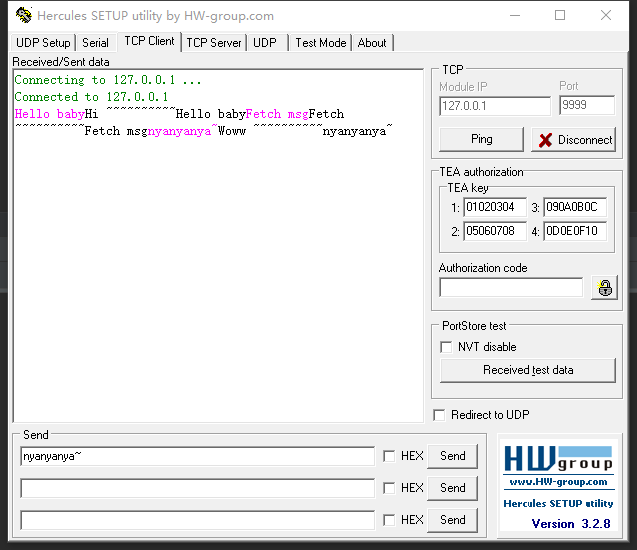
並且伺服器日誌如下:
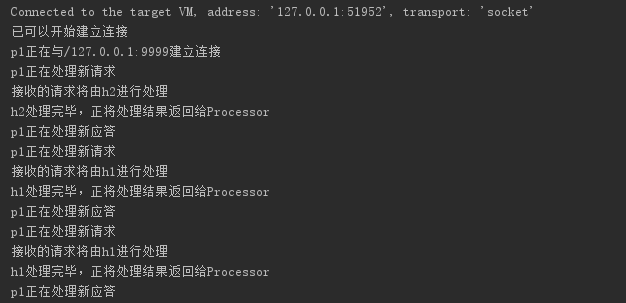
我們發現,h1和h2都會從RequestChannel中獲取任務來進行執行~ 當然如果連線增多,p1和p2也會從交替從Accept中獲取新的連線。
具體的程式碼請點選這裡,直接拉取下來即可執行,執行的主類是 src/reactor/Reactor
覺得好的話可以順手為文章點個贊喲~謝謝各位看官老爺!
參考文獻:
Kafka 原始碼 0.10.0.1
